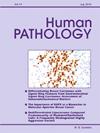胰腺导管火腿肠瘤:临床病理学研究
IF 2.7
2区 医学
Q2 PATHOLOGY
引用次数: 0
摘要
背景:已注意到胰腺中存在类似肝脏von-Meyenburg复合体(VMC)/胆管火腿状瘤的良性导管增生性病变,但其发病率、临床病理特征和发病机制仍不清楚。我们在此介绍3例表现为囊肿的患者,并将其称为胰管火腿肠瘤(PDH):方法:我们在一个多机构合作小组中发现了三例 PDH 病例,并对其临床病理进行了回顾。此外,我们还对本机构的 115 例连续胰腺切除术进行了检查,以发现偶然出现的 PDH:每个病例都是在腹部症状或大体检查时发现病变的。临床上怀疑每例病例均为胰腺导管内粘液性囊肿(IPMN),因此进行了胰腺切除术。在接受检测的患者中,有 2 人的囊液 CEA 升高。患者的年龄和性别分别为 73/M(病例 1)、68/F(病例 2)和 73/M(病例 3)。在病例 1 中,除了较大的囊性病变外,整个胰腺还可见许多微小病变(0.1-0.3 厘米)。在病例 2 中,这是唯一的病变,而在病例 3 中,则有另一个胃型 IPMN,并伴有高度发育不良。在 115 例连续的胰腺切除标本中,有 5 例(4.3%)发现了 PDH。PDH的大小为0.1-2.3厘米,组织学特征为不规则导管结构增生,内衬平滑扁平至低柱状上皮,有不同程度的囊性改变和管腔分泌物。内衬上皮从非粘液性胰胆管型到粘液性胃窝型不等,偶有鳞状化生。小结:PDH 见于所有胰腺切除术标本的 4.5%,偶然被发现,但偶尔也会变大和/或囊变,导致胰腺切除术。它们与胰腺癌或 IPMN 的关系目前仍不清楚。本文章由计算机程序翻译,如有差异,请以英文原文为准。
Ductal hamartoma of the pancreas: A clinicopathologic study
Background
Benign ductular proliferative lesions that resemble hepatic von-Meyenburg Complexes(VMC)/bile duct hamartomas have been noted to occur in the pancreas, but their incidence, clinicopathologic features and pathogenesis remains unknown. We present herein 3 patients that presented as cysts and call them pancreatic ductal hamartomas (PDH).
Methods
Three cases of PDH were identified form a multi-institutional collaborative group, and their clinicopathological were reviewed. In addition, we also examined 115 consecutive pancreatic resections at our institutions for the presence of incidental PDHs.
Results
The lesions were detected in each case during imaging for abdominal symptoms or grossing. The clinical suspicion was intra-ductal pancreatic mucinous cystic neoplasm (IPMN) in each case that led to pancreatectomy. The cyst fluid CEA was elevated in 2 of the patients tested. The patient age and gender were 73/M (case1), 68/F (case2) and 73/M (case3). In case1 besides the larger cystic lesion, numerous tiny lesions (0.1–0.3 cm) were seen throughout the pancreas. In case2 this was the only lesion, while in case3 there was another gastric-type IPMN with high-grade dysplasia. PDH were identified in 5(4.3%) of 115 consecutive pancreatectomy specimens. The PDHs measured 0.1–2.3 cm, and the histology is characterized by proliferation of irregular ductal structures lined by bland flattened to low columnar epithelium, variable cystic change and inspissated luminal secretions. The lining epithelium varied from non-mucinous pancreatico-biliary type to mucinous gastric foveolar-type, with occasional squamous metaplasia.
Summary
PDH are seen in 4.5% of all pancreatectomy specimens and detected incidentally, but occasionally may become large and/or cystic enough leading to pancreatectomy. Their relationship to pancreatic carcinoma or IPMN remains currently unknown.
求助全文
通过发布文献求助,成功后即可免费获取论文全文。
去求助
来源期刊

Human pathology
医学-病理学
CiteScore
5.30
自引率
6.10%
发文量
206
审稿时长
21 days
期刊介绍:
Human Pathology is designed to bring information of clinicopathologic significance to human disease to the laboratory and clinical physician. It presents information drawn from morphologic and clinical laboratory studies with direct relevance to the understanding of human diseases. Papers published concern morphologic and clinicopathologic observations, reviews of diseases, analyses of problems in pathology, significant collections of case material and advances in concepts or techniques of value in the analysis and diagnosis of disease. Theoretical and experimental pathology and molecular biology pertinent to human disease are included. This critical journal is well illustrated with exceptional reproductions of photomicrographs and microscopic anatomy.
 求助内容:
求助内容: 应助结果提醒方式:
应助结果提醒方式:


